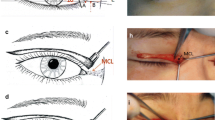Abstract
Background
The epicanthus, a lengthways cambered skinfold around the inner canthus, is particularly common in Orientals. The purpose of this study was to evaluate the surgical outcomes for patients with epicanthus after the application of a new surgical technique.
Methods
A total of 753 patients with epicanthus underwent epicanthoplasty in our hospital from October 2009 to March 2017 and were enrolled in this study. All patients were treated with upper arch flap combined with extended incision of the lower eyelid surgical method, and the effects of the surgery were assessed by photographic analysis and satisfaction surveys.
Results
After the surgery, the eyelids of patients were elongated, and their inner canthi diameter was shortened without recurrence in the epicanthus. For 3.32% of the patients, there was a nonuniform edge thickness of the lower eyelid incision; for 8.23% of the patients, there was a slightly lighter skin color in the rest of quondam arch flap. Six months after the surgery, the incision scar was not obvious for all patients, and most of the patients (90.31%) were satisfied with the effect of the surgery.
Conclusions
The upper arch flap combined with extended incision of the lower eyelid surgical method, a simple and effective surgical correction method, obtained a good cosmetic result with more secluded scar and high satisfaction for patients with epiblepharon.
Level of Evidence IV
This journal requires that authors assign a level of evidence to each article. For a full description of these Evidence-Based Medicine ratings, please refer to the Table of Contents or the online Instructions to Authors www.springer.com/00266.


Similar content being viewed by others
References
Lai CS, Lai CH, Wu YC, Chang KP, Lee SS, Lin SD (2012) Medial epicanthoplasty based on anatomic variations. J Plast Reconstr Aesthet Surg 65:1182–1187
Liu D, Hsu WM (1986) Oriental eyelids. Anatomic difference and surgical consideration. Ophthal Plast Reconstr Surg 2:59–64
Mustarde JC (1963) Epicanthus and telecanthus. Br J Plast Surg 16:346–356
Yoon K (1993) Modification of Mustarde technique for correction of epicanthus in Asian patients. Plast Reconstr Surg 92:1182–1186
Uchida J (1962) A surgical procedure for blepharoptosis vera and for pseudo-blepharoptosis orientalis. Br J Plast Surg 15:271–276
Kao YS, Lin CH, Fang RH (1998) Epicanthoplasty with modified Y-V advancement procedure. Plast Reconstr Surg 102:1835–1841
Mulliken JB, Hoopes JE (1975) W-epicanthoplasty. Plast Reconstr Surg 55:435–438
del Campo AF (1984) Surgical treatment of the epicanthal fold. Plast Reconstr Surg 73:566–571
Park JI (2000) Modified Z-epicanthoplasty in the Asian eyelid. Arch Facial Plast Surg 2:43–47
Yoo WM, Park SH, Kwag DR (2002) Root z-epicanthoplasty in asian eyelids. Plast Reconstr Surg 109:2067–2071
Roveda JM (1967) Epicanthus and blepharophimosis. Our technic of correction. Ann Ocul (Paris) 200:551–555
Liu H, Shao Y, Zhao Z, Zhang D (2014) One-stage correction of blepharophimosis-ptosis-epicanthus inversus syndrome using a frontalis muscle transfer technique. J Plast Surg Hand Surg 48:74–79
Li G, Wu Z, Tan J, Ding W, Luo M (2016) Correcting epicanthal folds by using asymmetric Z-plasty with a two curve design. J Plast Reconstr Aesthet Surg 69:438–440
Zhang H, Zhuang H, Yu H, Feng Y, Wang T, Hu S et al (2006) A new Z-epicanthoplasty and a concomitant double eyelidplasty in Chinese eyelids. Plast Reconstr Surg 118:900–907
Hwang K, Kim H (2016) Historical vignettes of epicanthoplasty. J Craniofac Surg 27:1080–1083
Hu X, Lin X, Ma G, Jin Y, Chen H, Chen X et al (2012) Two-Z-epicanthoplasty in a three-dimensional model of Asian eyelids. Aesthet Plast Surg 36:788–794
Zhao J, Qi Z, Zong X, Yang X, Song G, Du L et al (2016) A modified method combining Z-epicanthoplasty and blepharoplasty to develop out-fold type double eyelids. Aesthet Plast Surg 40:48–53
Park DH, Park SU, Ji SY, Baik BS (2013) Combined epicanthoplasty and blepharoptosis correction in Asian patients. Plast Reconstr Surg 132:510e–519e
Lee Y, Lee E, Park WJ (2000) Anchor epicanthoplasty combined with out-fold type double eyelidplasty for Asians: Do we have to make an additional scar to correct the Asian epicanthal fold? Plast Reconstr Surg 105:1872–1880
Saonanon P (2016) The new focus on epicanthoplasty for Asian eyelids. Curr Opin Ophthalmol 27:457–464
Wang L, Chen X, Zheng Y (2013) A modified z-epicanthoplasty combined with blepharoplasty used to create an in-type palpebral fissure in Asian eyelids. Aesthet Plast Surg 37:704–708
Yang SY, Yang JY, Hsiao YC (2015) Comparison of combination therapy (steroid, calcium channel blocker, and interferon) with steroid monotherapy for treating human hypertrophic scars in an animal model. Ann Plast Surg 74:S162
Weshahy AH, Abdel HR (2012) Intralesional cryosurgery and intralesional steroid injection: a good combination therapy for treatment of keloids and hypertrophic scars. Dermatol Ther 25:273–276
Author information
Authors and Affiliations
Contributions
SZ carried out the conception and design of the research, participated in the acquisition of data and drafted the manuscript. HX carried out the analysis and interpretation of data. SZ participated in the design of the study and performed the statistical analysis. HX conceived of the study and participated in its design and coordination and helped to draft the manuscript. All authors read and approved the final manuscript.
Corresponding author
Ethics declarations
Conflict of interest
No author has any potential conflict of interest.
Ethics Approval and Consent to Participate
This study was approved by Ethics Committee of Peking University Third Hospital.
Electronic supplementary material
Below is the link to the electronic supplementary material.
Rights and permissions
About this article
Cite this article
Zhang, S., Xue, H. Upper Arch Flap Combined with Extended Incision of Lower Eyelid: A Modified Epicanthoplasty in Correcting Epicanthus. Aesth Plast Surg 42, 1033–1038 (2018). https://doi.org/10.1007/s00266-018-1175-1
Received:
Accepted:
Published:
Issue Date:
DOI: https://doi.org/10.1007/s00266-018-1175-1




